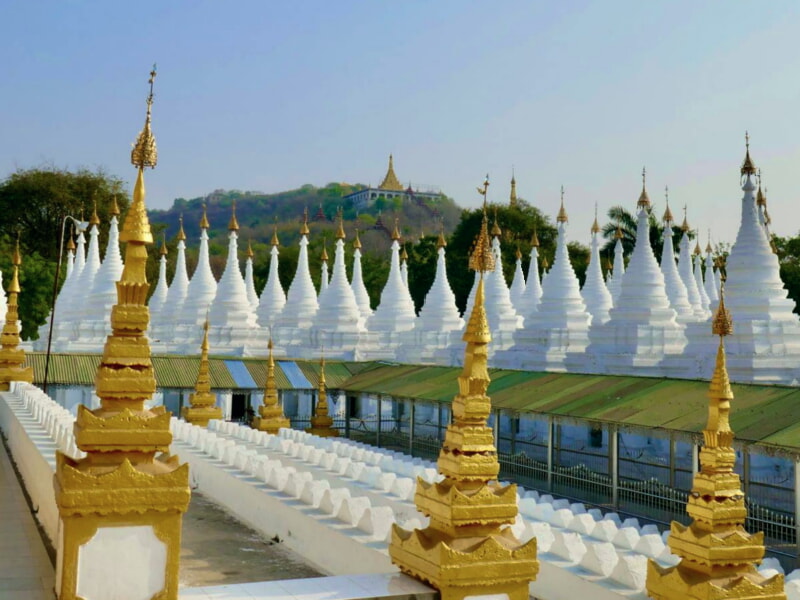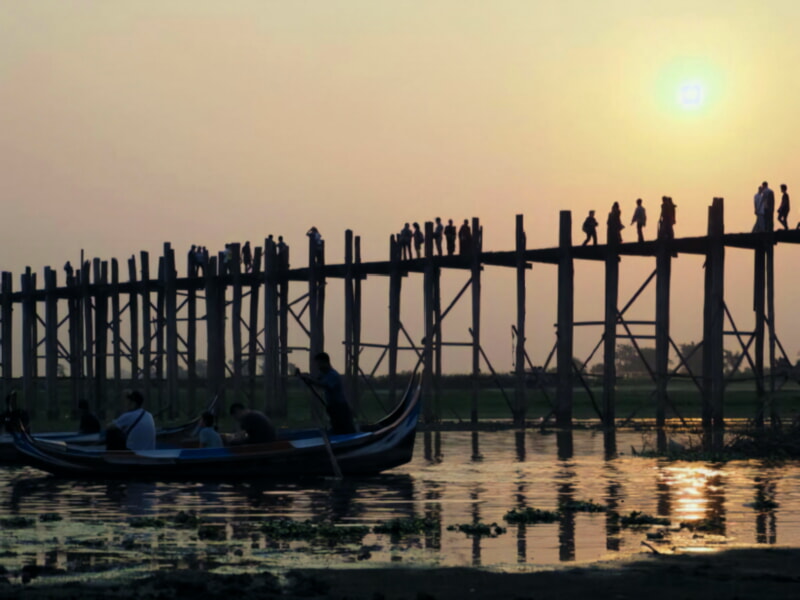Mandalay is a city and former royal capital of Myanmar (formerly Burma) on the Irrawaddy River. Its center is the restored palace of the Konbaung Dynasty surrounded by a moat.
At its foot is the Kuthodaw Pagoda, which houses hundreds of Buddhist-scripture-inscribed marble slabs. You can visit it without paying an entry fee with a Mandalay archaeological zone ticket.
Moat and Fortress Walls
The Moat and Fortress Walls of Mandalay are an impressive reminder of the city's past. A 230ft-wide moat and well over 4 miles of crenellated 26ft-high walls form a vast square around the site of the former Mandalay fortress/citadel.
The old moat and fortress walls are crowned at intervals by gate towers with intricate wooden topped carvings. The best way to see this is to stray away from the main drag and discover some of the lesser-known sites.
Shwenandaw Kyaung
The Shwenandaw Kyaung is a large building constructed in typical Burmese architectural style. It features a four-tiered roof that narrows toward the top of the structure. The roof lines are adorned with intricate wood carvings.
The roof bargeboards also contain carved demonstrations of mythical creatures, animals, dancers and flowers. These carvings are truly exquisite.
It is the only traditional teak wooden building remaining of the original Mandalay Royal Palace. The Palace was destroyed by fire during World War II and it is believed that this monastery was constructed to give visitors an impression of what the Royal Palace must have looked like before its destruction.

Mandalay Palace
The last Burmese royal palace, Mandalay Palace was constructed in 1857 and consists of a large complex that includes audience halls, throne rooms, a monastery, a watch tower, a court building, and a library with Buddhist scriptures.
The king wanted to build this palace at the foot of a hill that Buddha is believed to have set foot on, in order to turn Mandalay into a "Buddhist capital."
Much of the complex was destroyed during World War II by allied bombing but only one major wooden building survived - Shwenandaw Monastery, which is built entirely out of teak and decorated with detailed and ornate carvings. The surviving palace buildings are considered a key part of the cultural heritage of Myanmar and a must see for visitors.

Mahamuni Pagoda
The Mahamuni Pagoda is a major pilgrimage site and houses one of the most revered images of Buddha. It originally came from the Dhanyawadi city of Arakan in 554 BC and was breathed upon by the Buddha, turning it into a perfect likeness.
The temple also houses a collection of Buddhist inscription stones. These were collected by King Bodawpaya, who visited the area in 1784.
The golden statue in the central part of the temple is richly adorned with gold and diamonds. It is a favorite among worshipers who stick many pieces of gold leaf on the statue, which after several years accummulated in bulbous shapes in some areas.

U Bein Bridge
The longest teak footbridge across Taungthaman Lake, U Bein Bridge has become a popular site for tourists. It is a must-see for travelers who come to Mandalay in order to watch the beautiful sunset over the lake.
It was built in 1850 by Mayor U Bein using reclaimed teak wood from the former royal palace in Inwa. The bridge stretches 1.2 kilometers and features more than 1,000 wooden pillars that have been reinforced with concrete to ensure longevity.
The bridge is a vital pedestrian crossing for locals and has become a major tourist attraction, drawing thousands of visitors each year. It is especially crowded at sunset, when small boats chartered by tourists flow under and around the bridge.
Mandalay Marrionettes Theater
The Mandalay Marionettes Theater is one of the best places in Mandalay to experience traditional Burmese culture and history. The show consists of colorful marionettes that are made by hand and is a unique experience.
- Myanmar has a rich marionette puppet tradition, dating back to 500 years. This form of dramatic art served as a means of making people aware of current events; a medium for education in literature, history and religion; as a display of lifestyles and customs; and as mouthpieces for the people during the days of royalty.
- The practice of traditional marionette puppetry has waned over the decades, and is on the verge of becoming a lost art. In 1986, Mrs. Ma Ma Naing and Ms. Naing Yee Mar established the Mandalay Marionettes Theater as a way to preserve this legacy.

